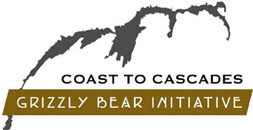In fall 2016 two bears were shot and killed on the N'Quatqua First Nation reserve. The bears had come accustomed to human presence and were unfairly deemed to pose a threat to human safety. These occurrences have become far too familiar in the region, and it continues to sadden and anger many community members who want to know what can be done to prevent future tragedies from occurring.
With the help of Coast to Cascades Grizzly Bear Initiative, team member Jolene Patrick, is shedding light on the alternative solutions to preventing conflicts between bears and humans. Jolene is herself a member of the N'Quatqua First Nation, a St’át’imc community 100 km southwest of Lillooet. Since August 2016 Jolene has been working in areas of the St’át’imc Nation to educate community members about living safely with bears,helping to build on programs initiated by the St’át’imc Government Services team.
In the fall, having established a Community Grizzly Bear working group, Jolene worked with N'Quatqua members to map potential bear attractants such as garbage dumps and fruit trees. Alongside community members a fruit harvest was organized to deter hungry bears and to distribute the local fruit among the community. The hope is to conduct similar mapping initiatives and develop conflict prevention solutions with the other St’át’imc communities in the new year.
Many bear awareness initiatives work from the assumption that the best way to prevent conflict is to keep human and bear spaces separate. For the St’át’imc however, this is impossible. As Jolene explains "In terms of land use overlap between bears and the communities, I'd say it's almost 100%." Many St’át’imc members are active land users, spending a lot of time out in the bush, fishing, hunting or gathering berries and medicines. Jolene's work recognizes that the St’át’imc have shared their territory with bears for millennia and will hopefully continue to do so in the future. Instead of discouraging people to be out on the land, her hope is to develop tools and habits for people to continue their traditional practices while reducing the risk of conflicts that put bears or humans at risk
In October Jolene hosted a community presentation in N'Quatqua to introduce Coast to Cascades' work and discuss with community members what a St’át’imc-lead grizzly bear conservation initiative could look like. The event brought together 30 participants from 6 out of the 11 different St’át’imc communities. Future events with discussions on conservation priorities and guest presenters are planned for the new year. "People were very receptive to Coast to Cascades, very interested to learn about what the organization is.” The presentation ended with a bear dance ceremony by St’át’imc Bear Dancers.
The grizzly bear occupies an important place in St’át’imc culture. According to traditional teachings it was the grizzly bear who first taught the St’át’imc what foods to eat. According to Jolene, cultural significance is one of the reasons why the community has been so supportive of her work. "First Nations people are closely associated with the land as well as certain species and grizzly bears are high up. You don't have to remind First Nations that there is a cultural connection." The hope is to draw on the wealth of traditional knowledge about grizzly bears in St’át’imc Nation to continue grizzly bear conservation that aligns with St’át’imc values.
The communities Jolene works with still face many barriers in realizing this vision. Resources and capacity within the communities are often limited. As well government and industry continue to offer little more than lip-service to First Nations when it comes to decision-making over land use. "Even if a community has declared a certain area a no-go zone, often the government won't respect the stance of the First Nation." Jolene, like many St’át’imc, would like to see communities have greater power in saying what kinds of activities occur on the territory including the power to say no to development that put wildlife habitat at risk. When it comes to development in the region, "There has to be a maximum.” The hope is that conservation groups will do a better job than they have in the past in supporting Indigenous decision-making over their territory.
Ultimately Jolene's goal is that people, will become more sympathetic and understanding towards grizzly bears. "They also have a right to live. They have a right to live where there's good habitat. The bears have as much right to this land as humans."
To learn more about the work being done to protect grizzly bears in Southern BC, join the Coast to Cascades mailing list.

